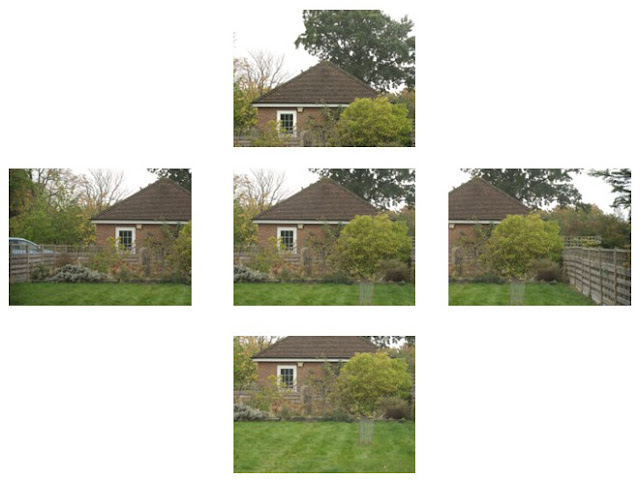In Praise of... Shift Lens Adapter on Fuji GFX 50s ii
One of the ways I justified to myself the expense of my Fuji GFX 50s ii medium format digital camera was I could get adapters and make use of the large number of medium format and 35mm lenses I already have. I have made a few posts about my experience, one of which is here...
I ended up getting a Kipon shift adapter for my 645-lens adapter. It is more expensive, bulkier and heavier, but I have a lot of 4x5 experience and often use tilt and rise and thought it would be useful to play with. Tilt is less important I think as depth of field control on the smaller sensor is less of a problem.
Initially, however, I thought the best use would be taking very large, stitched photos by shifting the lens and then rotating it to create a lot of overlapping images. Alas I haven't tried this yet.
For those unfamiliar with shift lenses, I give the following simple example. These photos were taken from the same fixed position on a tripod pointing at the same point. The only changes made for each image is the shift. The left/right shift is limited to +/- 10mm to stay away from vignetting (see technical discussion below). Up/down is +/-15mm. One additional aspect of this is that there is no angular distortion that would have happened by aiming the camera up/down or left/right. All of the lines in the building remain parallel.
 |
| Shift lens example (+/-10mm left/right and +/-15mm up/down) |
The shift up shown above does not seem like much yet I found I had to take my tripod up to the next higher floor to find a similar framing with the camera facing level. This means I was probably experiencing an effectove change of position of close to 10 ft. How do we understand this seemingly astonishing effect.
Without going in to the lens formulas I thought I could formulate a way to think about this. Firstly I for this imge used a 150mm focal length lens. The building at the back of my garden I would guess to be about 16ft tall to the top of the roof. Given the extra space above and below let us just say the hieght of the scene is 20ft. 20ft is 20ft x 12inches/ft x 25.4mm/inch or about 6100mm. The sensor size is about 32mm high. This means that every mm on the sensor translates to 6100mm / 32mm or about 190mm/mm on the scene. The shift was 15mm so 15mm x 190mm/mm is 2860mm which is about 9 ft.
What I have found is the shift function can be profoundly useful. I have found the following benefits.
- Avoiding weeds and vegetation in the foreground
- Getting over people's heads from the back of a crowd
- Getting around foreground trees when moving left or right further is not possible
- Taking a very low perspective further
- Expanding the distance between foreground and background subject on flat ground
- Adjusting left or right to keep the sun that is in frame behind a tree or other object.
 |
| Low Shot Taken Lower (down shift) |
 |
| Taken over the heads of fellow passengers on the ferry from the Orkneys back to Scrabster (up shift) |
 |
| Over the tops of tall grasses in the foreground. (up shift) |
Here is an example of what a shift can do to open up space between foreground and background subjects on a flat plane. In the first is a grebe on the lake taken without a shift. The space between the grebe and the islands is compressed as I was standing close to the shore.
 |
| No Shift |
In the next image taken from a similar place (note the same island on the left) I used the shift up function to create more separation between the grebes and the island.
Technical Details
In general, the major challenge with shift lenses is the image coverage area of the lens. Since the Mamiya 645 lenses are meant to cover to cover a piece of film that is nominally 60mm x 45mm this should not be too much of a problem for the Fuji GFX sensor which is smaller at 44mm x 32mm.The Kipon shift allows a shift of up to +/- 15mm. It has a rotation capability so this can be applied in any direction (up/down left/right) with detents and locking positions every 30 degrees.
 |
| Kipon Adapter Shift Scale |
When shifting left and right the lens coverage needs to be 44mm (sensor width) + 30mm (shift range) to give full coverage. 44mm is the sensor size and 30mm is the full +/-15mm shift range. This gives a need to cover 74mm left/right. We know the lens is designed to cover at least 60mm for the film. I ran some experiments with my 150mm f3.5 lens by shooting a portion of the sky and exaggerating the contrast in post processing in different shift positions. All photos were taken at f16. The result is heavy vignetting at 15mm shift and it is gone by 10mm. (44mm + 20mm = 64mm)
 |
| Vignette due to left shift 15mm to 10mm left to right. |
For up/down shifts the calculations are 32mm (sensor size) + 30mm (shift range) this results in 62mm of coverage. The 645 lenses tend to have an internal rectangular mask that might restrict the up/down shift to 45mm but the way the Kipon shift lens works in up/down mode is that the lens is rotated 90 degrees which means you get the full 60mm nominal range. My simple tests seem to bear this out as there is no obvious vignetting though perhaps a slight amount at 15mm up shift.
 |
| Vignette due to up shift 15mm to 10mm left to right. |

Comments